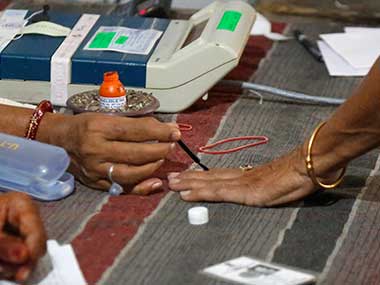India’s 2014 general election was the largest democratic event in the history of mankind, just by the sheer size of the electorate. A total of 814 million people were eligible to vote in the election. However, of these, only 66.4 percent actually voted. On the face of it, this seems like a decent number. But given the numbers, that means 273.5 million eligible voters did not vote. To put this into perspective, this figure is more than the entire population of Brazil and Indonesia (the 4th and 5th most populated countries in the world), respectively. One hundred and eight countries had a higher voting percentage than India. A dismal rank, as highlighted in the table below:
| 1 | Vietnam | 99.26% |
|---|---|---|
| 2 | Rwanda | 98.80% |
| 3 | Laos | 97.94% |
| 4 | Singapore | 93.56% |
| 5 | Ethiopia | 93.22% |
| 6 | Malta | 92.06% |
| 7 | Turkmenistan | 91.69% |
| 8 | Australia | 91.01% |
| 9 | Antigua and Barbuda | 90.27% |
| 10 | Solomon Islands | 89.93% |
| 11 | Luxembourg | 89.66% |
| 12 | Uruguay | 89.62% |
| 13 | Faroe Islands | 89.50% |
| 14 | Belgium | 89.37% |
| 15 | Guinea-Bissau | 88.57% |
| 16 | Uzbekistan | 88.51% |
| 17 | Seychelles | 87.61% |
| 18 | Bolivia | 87.45% |
| 19 | Sweden | 87.18% |
| 20 | Bahamas | 86.91% |
| 21 | Turkey | 86.22% |
| 22 | Denmark | 85.89% |
| 23 | Cuba | 85.65% |
| 24 | Botswana | 84.75% |
| 25 | Sierra Leone | 84.20% |
| 26 | Equatorial Guinea | 84.01% |
| 27 | Aruba | 83.96% |
| 28 | Cambodia | 83.02% |
| 29 | Nauru | 82.48% |
| 30 | Malaysia | 82.32% |
| 31 | Tajikistan | 82.00% |
| 32 | Philippines | 81.95% |
| 33 | Netherlands | 81.93% |
| 34 | Peru | 81.88% |
| 35 | Ecuador | 81.74% |
| 36 | Timor-Leste | 80.98% |
| 37 | Sao Tome and Principe | 80.65% |
| 38 | Austria | 80.00% |
| 39 | Tuvalu | 79.99% |
| 40 | New Zealand | 79.75% |
| 41 | Brazil | 79.50% |
| 42 | Iceland | 79.18% |
| 43 | Cook Islands | 79.12% |
| 44 | Norway | 78.22% |
| 45 | Maldives | 77.93% |
| 46 | Liechtenstein | 77.82% |
| 47 | State of Palestine | 77.70% |
| 48 | Sri Lanka | 77.66% |
| 49 | Kenya | 77.37% |
| 50 | Kazakhstan | 77.10% |
| 51 | Papua New Guinea | 76.89% |
| 52 | Cameroon | 76.79% |
| 53 | Argentina | 76.74% |
| 54 | Germany | 76.15% |
| 55 | Angola | 76.13% |
| 56 | Panama | 75.19% |
| 57 | Indonesia | 75.11% |
| 58 | Yemen | 74.98% |
| 59 | Belarus | 74.68% |
| 60 | Mauritius | 74.41% |
| 61 | Burundi | 74.32% |
| 62 | Cayman Islands | 74.06% |
| 63 | Venezuela | 73.76% |
| 64 | Grenada | 73.65% |
| 65 | Mongolia | 73.58% |
| 66 | South Africa | 73.48% |
| 67 | Montenegro | 73.41% |
| 68 | Saint Vincent | 73.39% |
| 69 | Anguilla | 73.24% |
| 70 | Samoa | 73.06% |
| 71 | Bermuda | 72.98% |
| 72 | Greenland | 72.95% |
| 73 | Italy | 72.93% |
| 74 | Suriname | 72.72% |
| 75 | Belize | 72.69% |
| 76 | Liberia | 72.49% |
| 77 | Mauritania | 72.46% |
| 78 | Israel | 72.34% |
| 79 | Guyana | 72.19% |
| 80 | Saint Kitts | 72.19% |
| 81 | Namibia | 72.00% |
| 82 | Fiji | 71.92% |
| 83 | Bhutan | 71.46% |
| 84 | Comoros | 71.35% |
| 85 | Guatemala | 71.13% |
| 86 | Montserrat | 71.06% |
| 87 | Gibraltar | 70.77% |
| 88 | Monaco | 70.35% |
| 89 | Malawi | 70.07% |
| 90 | Kuwait | 70.00% |
| 91 | Spain | 69.84% |
| 92 | Myanmar | 69.72% |
| 93 | Hungary | 69.67% |
| 94 | United Kingdom | 68.93% |
| 95 | Nepal | 68.67% |
| 96 | Canada | 68.28% |
| 97 | Dominican Republic | 67.77% |
| 98 | Uganda | 67.61% |
| 99 | Ghana | 67.55% |
| 100 | Kiribati | 67.54% |
| 101 | Tunisia | 67.43% |
| 102 | Bahrain | 67.00% |
| 103 | Tonga | 67.00% |
| 104 | Finland | 66.85% |
| 105 | Trinidad and Tobago | 66.84% |
| 106 | Macedonia | 66.79% |
| 107 | Cyprus | 66.74% |
| 108 | Virgin Islands | 66.58% |
| 109 | India | 66.40% |
One could argue that a percentage wise list might in some cases not be a relevant (or fair) reference benchmark to evaluate India’s performance, simply because the numbers of electorate is significantly lower in most of these countries. Therefore, the chart below indicates a list of top 30 countries, with largest voter registrations and their voter turnouts. Here too, it can be clearly seen that although India lies in the median range, there is massive scope for improvement. Countries with similar socio-economic conditions such as Brazil, Philippines, Vietnam, Indonesia, Argentina performed much better than India. The larger point being that there is a huge section of the Indian population, which can and should vote, but doesn’t exercise its right. When you convert the percentages into numbers, they put into question the very legitimacy of elections, and by implication, of democracy, in India. In most elections in India (Assembly polls), it is safe to presume that the winning party gets around 40 percent of the total votes cast. In Lok Sabha elections, the percentage goes down further, to around 30 to 35 percent. In the last elections, the BJP won 282 seats, while clocking a 31.4 percent vote share. Now, imagine there’s a 10% increase in voter turnout (meaning around 81.4 million more people voting). This can potentially change the whole landscape. It has been traditionally argued elsewhere that rural India polls more percentage than urban India. Hence, there exists a larger scope for increase of voter turnout in urban areas than rural areas. Customarily, India’s urban areas have had a higher preference for the BJP. The recent Assembly elections have not been an exception. There is direct evidence that urban India votes less, but prefers the BJP. Hence, the direct beneficiary of a higher voter turnout, especially in urban areas, is naturally the BJP. Maybe this could have played a crucial part in the cliffhanger of a contest in Madhya Pradesh and Rajasthan. An obvious electoral strategy for the BJP should be increasing voter turnout. Australia has set the example by making voting compulsory. Failure to vote in Australia can attract a fine of up to $50. In addition, Argentina, Belgium, Brazil and a host of other countries enforce some form of compulsory voting. There are arguments that such a move could result in “donkey-voting”, a practice where voters (who do not have any voting preferences) turn-up and vote at random, mostly for the anyone which appears first on the ballot paper/machine. This argument is based on the assumption that most non-voters are either disinterested or simpletons incapable of reason. The essence of any democracy is to treat its electorate as mature and aware, and therefore this (speculative) argument holds little water. Others argue that compulsory voting will result in people having to forcefully choose political sides when they have consciously decided not to. A valid concern, but which has already been addressed through NOTA. Critics argue, perhaps rightly so, that voting is a natural right of liberty which includes the freedom to not vote, and therefore no one can be compelled to vote. Admittedly, this does put a spanner in any plans to introduce compulsory voting in India, especially in the current climate of rampant judicial activism. However, what the government can do is incentivise voting through mechanisms such as nominal income tax credits, rebates or subsidies. The Election Commission has plans to link Aadhaar (already linked with PAN) with voter ID cards, which would make for a smooth implementation from an operational perspective. Given that the middle class, which is the conventional voter base of the BJP, is also the tax paying class, such a move will also make a lot of political sense for the BJP. Before critics of BJP accuse it of using Machiavellian tactics, they will perhaps be happy to learn that studies have shown that compulsory voting has resulted in an increased support of leftist policies. There is a robust case to shed the status-quo and to take proactive steps to increase India’s voter turnout, not only to lend credibility to election results but also in order to make India’s democracy more inclusive, vibrant and truly representative. Raghav Pandey is an assistant professor of Law at Maharashtra National Law University, Mumbai and Kumar Venkatesh, is a corporate lawyer based in London.


)

)
)
)
)
)
)
)
)



